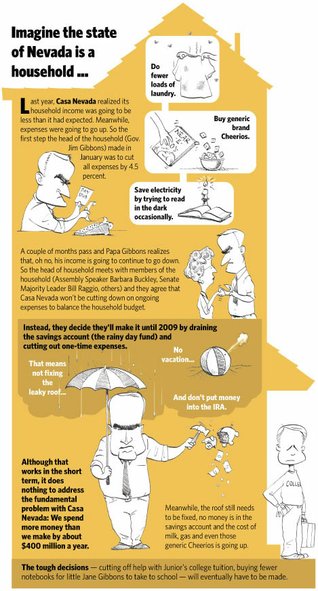Friday, April 25, 2008 | 2 a.m.
A second round of budget cuts eliminated nearly $400 million in Nevada’s spending, meeting the requirement that the state keep its financial books balanced.
Despite dire predictions of layoffs and cuts to schools and social services, most of the doomsday scenarios did not occur.
Don’t be lulled into believing the worst is over, though.
From the Legislature to the governor’s office, officials acknowledge that the latest round of cuts only delayed difficult decisions still to be made about the size of state government and whether taxes are sufficient.
Gov. Jim Gibbons and a bipartisan group of legislators who came up with the cuts relied on short-term fixes, such as delaying construction projects, not setting aside money for future retirement costs and draining the state’s rainy day fund.
But tougher choices are on the horizon.
The fundamental problem in the state’s budget is this: Next fiscal year, revenue is projected to be $400 million less than ongoing costs. That shortage represents about 11 percent of the state’s expenses, estimated at $3.5 billion.
“The more challenging issue of balancing the budget is yet to come,” said Andrew Clinger, Gibbons’ budget director.
“We’ve put off fixing the leaky roofs,” state Sen. Bob Beers, R-Las Vegas, said of the most recent cuts. “But next year, the roof will still need to be fixed, and meanwhile the cost of government is going to keep increasing.”
Most observers predict that unless the economy rebounds, the 2009 session is likely to be brutal, with legislators agonizing over proposals for severe cuts in education and social services and a sharp reduction in the size of state government.
Gibbons has vowed not to raise taxes. The Legislature is unlikely to push him on the matter, both because of politics — after the legislative session ends in April, the 2010 gubernatorial race will start in earnest — and pragmatism (votes of two-thirds of both houses of the Legislature are required to raise taxes).
State Republicans are talking about diverting money from local governments. Democrats are studying the tax exemptions the state offers, viewing the elimination of some as a potential revenue source.
Nevada has drained its savings account, the rainy day fund, intended to be a short-term answer to hard economic times.
“So far all they’ve done is kick the can down the road hoping things will turn around before they have to make the tough decisions,” said Chuck Muth, a conservative activist.
Muth predicts that, even with the two rounds of cuts made, the budget numbers will look bleak by the end of next month, forcing Gibbons and legislators to make tougher calls. Like others, Muth would not be surprised to see a third round of budget cuts this year.
Beers said, “We’re banking very, very heavily that the economy comes raging back.”
If it doesn’t, painful decisions will have to be made in advance of next year’s legislative session.
Gibbons administration officials and legislators who worked on the earlier budget cuts defended their approach to date, while acknowledging their actions only delayed more substantive decisions.
The full Legislature meets only four months every other year, with the next session slated to begin in January. The committee that Gibbons met with was informal, though it consisted of legislative leaders including Sen. Bill Raggio, R-Reno, and Assembly Speaker Barbara Buckley, a Las Vegas Democrat.
Buckley said those budget discussions were not the right place for a deeper debate about the state’s future.
“We didn’t sit down to resolve fundamental disagreements about government,” Buckley said. “We sat down to make sure we meet financial obligations due to shortfalls.”
She added: “I, for one, don’t want to rush and cut education.”
Clinger said delaying the decision until the legislative session “gives us more time to evaluate the budget and to make some of the more difficult decisions to fix that structural deficit moving forward.”
The state also is working on establishing a commission to examine waste in state government.
Because the state Legislature passes a two-year budget, Clinger said, given current projections, state leaders will be looking at a minimum $800 million deficit in the budget for the period that begins in July 2009 and ends in June 2011.
In January, Gibbons ordered state agencies to cut 4.5 percent from their budgets. This month, with state revenue still falling short of projections, the Republican governor met with legislative leaders to come up with a second round of cuts.
State Controller Kim Wallin, a Democrat, has refused to process those cuts, saying an interim legislative committee must approve the reductions.
Wallin’s stance means state agencies essentially are getting checks for more money than the governor has said they may spend, creating the potential for careless — or rogue — state bureaucrats to spend money Gibbons ordered them to set aside.
State departments have been bringing at least some of the cuts to the Interim Finance Committee for approval. But if forecasts are correct, the cuts already announced won’t be enough.
“These buy us a little more time,” Clinger said. “Not a whole lot.”
Muth thinks the governor and legislators settled on the cuts because they were the easiest to make.
“This has the fewest number of people screaming,” Muth said. “All they are doing is putting off the inevitable.”


Join the Discussion:
Check this out for a full explanation of our conversion to the LiveFyre commenting system and instructions on how to sign up for an account.
Full comments policy